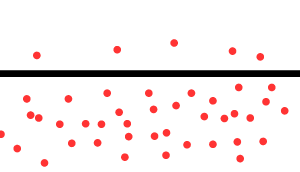| Consider the animation on the right. It shows solute been moved through the cell membrane. This is most likely
to involve the expenditure of energy as the solute particles move against the diffusion gradient from low to high concentration. |
 |
Consider the animation on the right. It shows solute been moved through the cell membrane. No energy is expended and is most likely to involve facilitated transport as the solute particle move along the diffusion gradient from high to low concentration.
|
 |
| Which of the following are most likely to be expelled from the cell by exocytosis?
Large molecules, such as proteins, are expelled from the cell by exocytosis.
|
| The concentration of calcium in a cell is 0.3% while the concentration in the surrounding tissue is 0.1%. How could the cell obtain more calcium?
Active transport involves the expenditure of energy as solute particles are forced to move from an area of low concentration to a high concentration.
|
| Which of the following best describes the general structure of the cell membrane?
Proteins embedded in two layers of phospholipid.
|
| What is the difference between passive and active transport? Passive transport requires diffusion of solutes down a concentration gradient and active transport uses energy to move solutes up a concentration gradient form low to high concentrations. |
| How does the cell control the amount of water in the cytoplasm if it does not actively transport water? Water passes by diffusion from a region where it is in high concentration to a region of lower concentration. Since the cell does not actively transport water it controls the movement of water by actively transporting solutes such as sodium ions (Na+). By actively transporting ions, such as sodium, changes to the concentration of water occur and water diffuses across the membrane down a concentration gradient. |
| |

